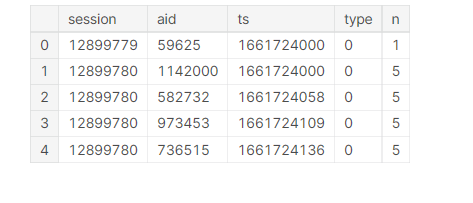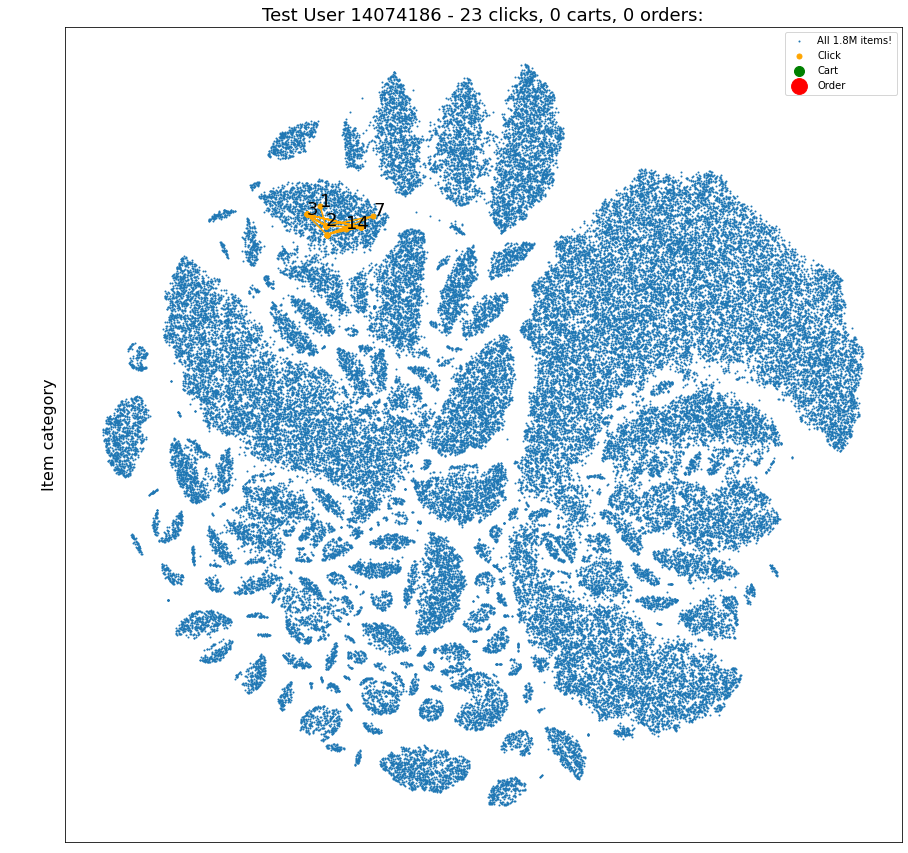本文主要是介绍kaggle学习笔记-otto-baseline6-使用 RAPIDS TSNE 和项目矩阵分解可视化用户行为,希望对大家解决编程问题提供一定的参考价值,需要的开发者们随着小编来一起学习吧!
简介
在Kaggle的Otto推荐系统竞赛中,项目ID是匿名的。所以我们不知道每个项目 id 指的是哪个。但是,通过项目矩阵分解,我们可以将匿名项目 ID 转换为有意义的嵌入。那么类似的嵌入将是类似的项目。如果我们将嵌入投影到 2D 平面(使用 TSNE、UMAP、PCA 等)并绘制它们,我们可以看到类似项目的集群。然后一个集群可能是服装,另一个集群可能是电子产品等。
使用项目嵌入的 2D 平面,我们可以绘制点和线,显示每个用户活动的进展。这使我们能够了解用户如何购物。用户是否浏览类似的项目,然后查看不同的项目,然后返回购买原始项目。用户主要探索类似项目吗?还是用户探索各种项目?下面的图将阐明用户行为,帮助我们理解数据并构建更好的功能和模型。
数据处理
import cudf
print('RAPIDS cuDF version',cudf.__version__)train = cudf.read_parquet('../input/otto-full-optimized-memory-footprint/train.parquet')
test = cudf.read_parquet('../input/otto-full-optimized-memory-footprint/test.parquet')train_pairs = cudf.concat([train, test])[['session', 'aid']]
del train, testtrain_pairs['aid_next'] = train_pairs.groupby('session').aid.shift(-1)
train_pairs = train_pairs[['aid', 'aid_next']].dropna().reset_index(drop=True)cardinality_aids = max(train_pairs['aid'].max(), train_pairs['aid_next'].max())
print('Cardinality of items is',cardinality_aids)
安装 Merlin 下载器
!pip install merlin-dataloader==0.0.2
from merlin.loader.torch import Loader train_pairs.to_pandas().to_parquet('train_pairs.parquet') # TRAIN WITH ALL DATA
train_pairs[-10_000_000:].to_pandas().to_parquet('valid_pairs.parquet')from merlin.loader.torch import Loader
from merlin.io import Datasettrain_ds = Dataset('train_pairs.parquet')
train_dl_merlin = Loader(train_ds, 65536, True)
使用 PyTorch 矩阵分解模型学习项目嵌入
import torch
from torch import nnclass MatrixFactorization(nn.Module):def __init__(self, n_aids, n_factors):super().__init__()self.aid_factors = nn.Embedding(n_aids, n_factors, sparse=True)def forward(self, aid1, aid2):aid1 = self.aid_factors(aid1)aid2 = self.aid_factors(aid2)return (aid1 * aid2).sum(dim=1)class AverageMeter(object):"""Computes and stores the average and current value"""def __init__(self, name, fmt=':f'):self.name = nameself.fmt = fmtself.reset()def reset(self):self.val = 0self.avg = 0self.sum = 0self.count = 0def update(self, val, n=1):self.val = valself.sum += val * nself.count += nself.avg = self.sum / self.countdef __str__(self):fmtstr = '{name} {val' + self.fmt + '} ({avg' + self.fmt + '})'return fmtstr.format(**self.__dict__)valid_ds = Dataset('valid_pairs.parquet')
valid_dl_merlin = Loader(valid_ds, 65536, True)
from torch.optim import SparseAdamnum_epochs = 10
lr=0.1model = MatrixFactorization(cardinality_aids+1, 32)
optimizer = SparseAdam(model.parameters(), lr=lr)
criterion = nn.BCEWithLogitsLoss()model.to('cuda')
for epoch in range(num_epochs):for batch, _ in train_dl_merlin:model.train()losses = AverageMeter('Loss', ':.4e')aid1, aid2 = batch['aid'], batch['aid_next']aid1 = aid1.to('cuda')aid2 = aid2.to('cuda')output_pos = model(aid1, aid2)output_neg = model(aid1, aid2[torch.randperm(aid2.shape[0])])output = torch.cat([output_pos, output_neg])targets = torch.cat([torch.ones_like(output_pos), torch.zeros_like(output_pos)])loss = criterion(output, targets)losses.update(loss.item())optimizer.zero_grad()loss.backward()optimizer.step()model.eval()with torch.no_grad():accuracy = AverageMeter('accuracy')for batch, _ in valid_dl_merlin:aid1, aid2 = batch['aid'], batch['aid_next']output_pos = model(aid1, aid2)output_neg = model(aid1, aid2[torch.randperm(aid2.shape[0])])accuracy_batch = torch.cat([output_pos.sigmoid() > 0.5, output_neg.sigmoid() < 0.5]).float().mean()accuracy.update(accuracy_batch, aid1.shape[0])print(f'{epoch+1:02d}: * TrainLoss {losses.avg:.3f} * Accuracy {accuracy.avg:.3f}')
提取项目嵌入
# EXTRACT EMBEDDINGS FROM MODEL EMBEDDING TABLE
embeddings = model.aid_factors.weight.detach().cpu().numpy()
print('Item Matrix Factorization embeddings have shape',embeddings.shape)
使用 RAPIDS TSNE 可视化用户行为
# IMPORT RAPIDS TSNE
from cuml import UMAP, TSNE, PCA
import matplotlib.pyplot as plt, numpy as np
import matplotlib.patches as mpatches, cuml
print('RAPIDS cuML version',cuml.__version__)# FIT TRANSFORM TSNE
em_2d = TSNE(n_components=2).fit_transform(embeddings)
print('TSNE embeddings have shape',em_2d.shape)
# LOAD TEST DATA
test = cudf.read_parquet('../input/otto-full-optimized-memory-footprint/test.parquet')
tmp = test.groupby('session').aid.agg('count').rename('n')
test = test.merge(tmp, left_on='session', right_index=True, how='left')
active_users = test.loc[test.n>20,'session'].unique().to_array()
test = test.sort_values(['session','ts'])
print('Test data shape:', test.shape )
test.head()

使用 TSNE 项目嵌入显示用户活动
对于 50 个随机用户(有 20 个或更多活动),我们将绘制他们的活动随时间的变化。顶部图显示与之交互的项目的类别,底部图显示项目交互的时间。当顶部图中的点彼此靠近时,则项目相似。例如,两件衣服将接近,而一件衣服将与一件电子产品相距甚远。
图中的数字按时间排序。数字 1 是用户与之交互的第一个项目,而数字 10 是第 10 个项目,依此类推。我们只显示一些数字,以便数字可读。橙色点是点击,绿色点是购物车,红点是买入。180万个蓝点都是独一无二的物品。我们观察到代表不同类别物品的蓝点簇。
x-y 平面表示不同的项目类别。如果用户呆在同一区域,那么他们正在购买类似的物品,例如服装部门。当用户的绘图从 x-y 平面的一个区域更改为另一个区域时,用户将更改为不同类别的项目,例如从服装购物转移到电子产品购物。我们观察不同类型的用户。一些用户浏览一个项目类别,而其他用户浏览各种项目类别。
# DISPLAY EDA FOR 50 USERS
for k in range(50):# SELECT ONE USER WITH 20+ CLICKSu = np.random.choice(active_users)dff = test.loc[test.session==u].to_pandas().reset_index(drop=True)tmp = dff.aid.valuesclicks = test.loc[(test.session==u)&(test['type']==0)].to_pandas().aid.valuescarts = test.loc[(test.session==u)&(test['type']==1)].to_pandas().aid.valuesorders = test.loc[(test.session==u)&(test['type']==2)].to_pandas().aid.values############## PLOT HISTORY BY ITEM CATEGORY############# PLOT CLICKS, CARTS, ORDERS OVER TSNE ITEM EMBEDDING PLOTplt.figure(figsize=(15,15))plt.scatter(em_2d[::25,0],em_2d[::25,1],s=1,label='All 1.8M items!')plt.plot(em_2d[tmp][:,0],em_2d[tmp][:,1],'-',color='orange')plt.scatter(em_2d[tmp][:,0],em_2d[tmp][:,1],color='orange',s=25,label='Click')plt.scatter(em_2d[carts][:,0],em_2d[carts][:,1],color='green',s=100,label='Cart')plt.scatter(em_2d[orders][:,0],em_2d[orders][:,1],color='red',s=250,label='Order')# PLOT NUMBERS OF ORDER VISITEDold_xy = []; pos = []for i,(x,y) in enumerate(zip(em_2d[tmp][:,0],em_2d[tmp][:,1])):new_location = Truefor j in old_xy:if (np.abs(x-j[0])<5) & (np.abs(y-j[1])<5):new_location = Falseif new_location:plt.text(x,y,f'{i+1}',size=18)old_xy.append( (x,y) ); pos.append(i)# LABEL PLOTplt.legend()plt.title(f'Test User {u} - {len(clicks)} clicks, {len(carts)} carts, {len(orders)} orders:',size=18)#plt.xlabel('Item category',size=16)plt.ylabel('\n\nItem category',size=16)plt.xticks([], [])plt.yticks([], [])plt.show()############## PLOT HISTORY BY DAY AND HOUR############mn = test.ts.min()dff['day'] = (dff.ts - mn) // (60*60*24)dff['hour'] = ((dff.ts - mn) % (60*60*24)) // (60*60)plt.figure(figsize=(15,3))xx = np.random.uniform(-0.2,0.2,len(dff))yy = np.random.uniform(-0.5,0.5,len(dff))plt.scatter(dff.day.values+xx, dff.hour.values+yy, s=25, color='orange')cidx = dff.loc[dff['type']==1].index.valuesoidx = dff.loc[dff['type']==2].index.valuesplt.scatter(dff.day.values[cidx]+xx[cidx], dff.hour.values[cidx]+yy[cidx], s=50, color='green')plt.scatter(dff.day.values[oidx]+xx[oidx], dff.hour.values[oidx]+yy[oidx], s=100, color='red')old_xy = []for i in range(len(dff)):if 1: #i in pos:x = dff.day.values[i]+xx[i]y = dff.hour.values[i]+yy[i]new_location = Truefor j in old_xy:if (np.abs(x-j[0])<0.5) & (np.abs(y-j[1])<4):new_location = Falseif new_location:plt.text(x, y, f'{i+1}', size=18)old_xy.append( (x,y) )plt.ylim((-1,25))plt.xlim((-1,7))plt.ylabel('Hour of Day',size=16)plt.xlabel('Day of Month',size=16)plt.yticks([0,4,8,12,16,20,24],['12am','4am','8am','noon','4pm','8pm','12am'])plt.xticks([0,1,2,3,4,5,6],['Mon\nAug 29th','Tue\nAug 30rd','Wed\nAug 31st','Thr\nSep 1st','Fri\nSep 2nd','Sat\nSep 3rd','Sun\nSep 4th'])c1 = mpatches.Patch(color='orange', label='Click')c2 = mpatches.Patch(color='green', label='Cart')c3 = mpatches.Patch(color='red', label='Order')plt.legend(handles=[c1,c2,c3])plt.show()print('\n\n\n\n\n\n\n')
这段代码产生的图片较多,这里只放两张作为示意


这篇关于kaggle学习笔记-otto-baseline6-使用 RAPIDS TSNE 和项目矩阵分解可视化用户行为的文章就介绍到这儿,希望我们推荐的文章对编程师们有所帮助!






